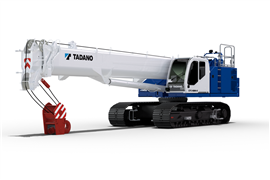An update on trucking-related legislation
31 July 2023
Proposed trucking bills are making their way through Congress.
Earlier this spring, a collection of trucking-related measures was approved by the House Transportation and Infrastructure Committee (HTIC). The measures will now move through the legislative process, with one proposal standing out more than most for SC&RA members.
On May 23, the HTIC approved the Truck Parking Safety Improvement Act, which would provide USDOT funding on a competitive basis for the construction of thousands of safe parking spots for trucks and make necessary improvements to existing truck parking areas.
Trucking stakeholders praised the HTIC’s approval of the Act, and SC&RA’s own Chris Smith, Vice President, Transportation, noted, “While this is one of the most important trucking issues being addressed in Congress at the moment, it’s still very important that we continue to educate both federal officials and state DOTs on the nuances of specialized transportation.”

Our perspective
Smith is referring to the fact that, most of the time when states and federal officials discuss parking improvement, they do so in the spirit of common commercial trucking.
Obviously, we understand why, but because we are so specialized, SC&RA has been working a lot with various planning groups in an effort to remind them that the same parking challenges apply to us, and so, too, should the solutions. Moreover, from a design perspective, our loads are going to take up more space and require different accommodations, so there’s a lot to consider, and a lot for SC&RA to advocate for.
As for net positives, SC&RA is encouraged by collaboration on the proposed bill as well as the overall size of it. At $755 million over three years, it will have a wide impact with long-term benefits. It also allows for expanding parking within an existing facility – which is particularly important for specialized loads, who often deal with borders and permit issues. And lastly, it’s bi-partisan – within a non-election year – so, the industry is much more likely to see a vote on it since there’s less risk for members of Congress at this time.
A good baseline
Additional proposed legislation to pay attention to involves easier access to training for prospective truck drivers. The LICENSE (Licensing Individual Commercial Exam-takers Now Safely and Efficiently) Act would make permanent two pandemic-era USDOT waivers that allow CDL skills test examiners to administer knowledge tests to applicants regardless of their state of origin.
Ultimately, the bill would expedite the CDL-issuing process while not posing a safety risk because of FMCSA’s Entry-Level Driver Training regulations. While the LICENSE Act should realize an easier pathway to licensure for commercial truck drivers, hopefully boosting the workforce, any benefits that could impact the specialized industry will likely be seen down the road. Making the CDL process easier is undoubtedly a good thing – it never hurts to have more drivers entering the industry. And those drivers are now one step closer to advancing their careers in the specialized space.
Silver lining
A third piece of proposed legislation to keep an eye on for industry supporters is HR 3372, which aims to establish a safety data collection program for certain six-axle vehicles. Ultimately, the bill would institute a voluntary 10-year pilot program for states to increase truck weights on federal interstates up to 91,000 pounds on six axles.
While this potential bill is also pointed more at commercial trucking versus specialized, it’s always worth examining the silver lining in any legislation that could enhance the overall trucking industry. A streamlined supply chain is a good thing for everyone, and while this legislation, if passed, would only nominally impact specialized carriers, there are some positives: potentially fewer trucks on the road, and more impact studies – which gives us a good baseline on the impact of heavier trucks.
The HTIC approved 17 overall bills in May, which will now go before the full House, with companion legislation in the Senate yet to be considered in committee.
STAY CONNECTED


Receive the information you need when you need it through our world-leading magazines, newsletters and daily briefings.
CONNECT WITH THE TEAM












